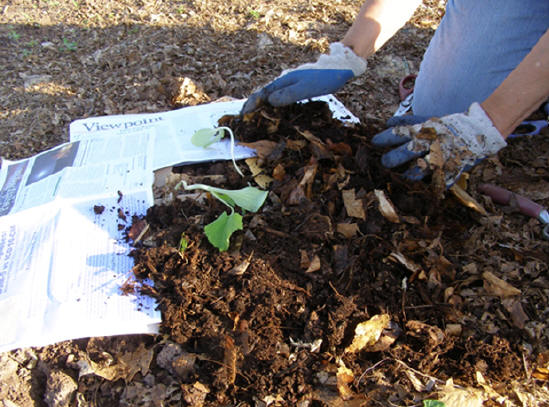|
Papering Your Garden
Mary Ellen Banks
Adams County Master Gardener
 “What’s black and white and green all over?” Well, it’s the same answer as for the old riddle: “What’s black and white and read all over?” Of course, that would be NEWSPAPER. You might be thinking what does a newspaper have to do with gardening, and you may be surprised to learn that
recycling paper in your garden is a green way to re-use this material and make your gardening tasks easier. Some people even recycle their “junk” mail by sorting out the colored and glossy paper and shredding the paper that is useful for their gardening tasks. “What’s black and white and green all over?” Well, it’s the same answer as for the old riddle: “What’s black and white and read all over?” Of course, that would be NEWSPAPER. You might be thinking what does a newspaper have to do with gardening, and you may be surprised to learn that
recycling paper in your garden is a green way to re-use this material and make your gardening tasks easier. Some people even recycle their “junk” mail by sorting out the colored and glossy paper and shredding the paper that is useful for their gardening tasks.
Newspapers, as well as paper bags, cardboard, and other non-glossy and uncolored papers, are recyclable and provide multiple benefits in your vegetable, flower or landscape gardens. Also, paper, especially when shredded, can supplement the other organic contents in compost bins. Paper or cardboard placed around you plants, shrubs or trees provide a weed barrier,
discourage the sprouting of light- dependent seeds, prevent soil erosion, and conserve moisture around plants. You can use shredded paper or even paper in its sheet form.
Tips for using paper in your garden can be found at multiple sites on the Internet from Pinterest, HGTV, to the New York Times. The West Virginia Cooperative Extension site has multiple articles regarding using paper for composting and garden mulch. Recycling paper in the garden is not a new idea. Ruth Stout’s now famous books on no-work gardening, including recycling
paper, first appeared in 1955. She achieved added notoriety for her novel approach to gardening in 1973 when Rodale Press published: The Ruth Stout No-Work Garden Book: Secrets of the Year-Round Mulch Method.
In the garden, newspapers, in their about-to-be-recycled form, can save hours of work. After reading and digesting the day’s news, turn those same pages into garden helpers. Before storing papers to use at a future time in a garden bed, remove all glossy and colored inserts, and the paper pile is ready to use.
For garden bed purposes use layers of paper to cover a garden in the fall. Paper around newly-planted beds in the spring. Using paper and cardboard to “pave” between rows of seedlings and plants for weed control are both worth a gardener’s effort. Any of these applications require a thickness of 4-5 sheets of paper product. That thickness of paper allows water to permeate
the paper and get through to the soil but not waterlog the roots of plants.

Early spring planting using newspaper and mulch keeps the weeds down
Using paper to lessen the work of gardening in vegetable and flower beds can start in the fall. After a hard frost ends the growing season, remove plant debris and add to a compost bin. Next, with enough paper and sufficient mulch at hand to keep the paper in place, cover the length and width of the garden. This layering of paper and
mulch will provide a barrier for the soil over the winter which discourages germination of light-dependent seeds the following spring and reduces the need to till the soil when it is time to plant. Over the course of the season, the paper and mulch winter cover will continue to compost and add nutrients to the soil.
For spring-time planting, stake rows as usual. Using scissors, expose the soil under the mulch and paper, trowel open a space for planting seeds, insert bedding plants, and cover the seeds and plants with soil. A bedding plant can benefit by placing new paper around the plant and covering the paper with additional mulch. At this point, the new plants and seeds are in
place with the space between planted rows remaining covered with paper and mulch applied the previous fall. If the mulch between the rows is thin after vegetables and flowers are planted, additional paper, shredded leaves, pine needles, coffee grounds, or grass clippings can be added to keep the space between the rows covered to a depth of 3-4 inches. Mulching the space
between the rows works to assist with water retention and weed suppression for the designated plants and provides covered pathways to tend the garden.
Using these practices during the seasons of a garden decreases the need to rototill or hand turn garden space protecting topsoil. The continual addition of mulch and compost increases soil structure and fertility and impedes soil compaction. Using paper and mulch in this way gives plants in a bed, garden or landscape an enhanced environment for growth without competition
from weeds for light, water, space, and soil nutrients. And, as recommended, testing garden soil at three-year intervals, or perhaps sooner, if a gardener is trying new gardening practices, assures that the soil and plant environment are optimal for good outcomes.
Read other articles on gardening techniques
Read other articles by Mary Ellen Banks
|